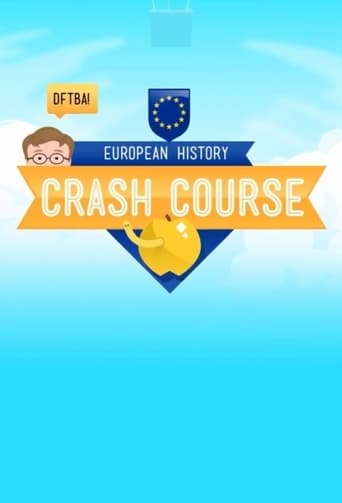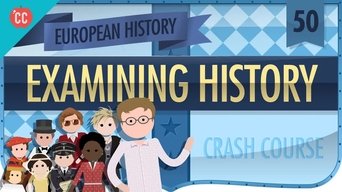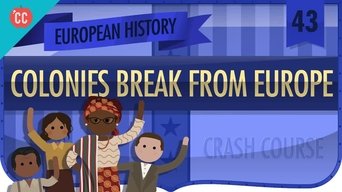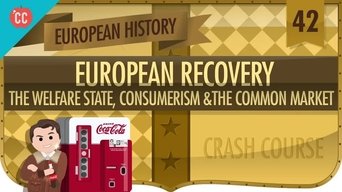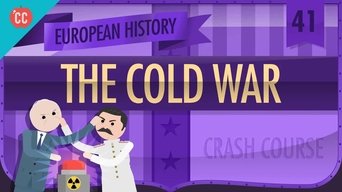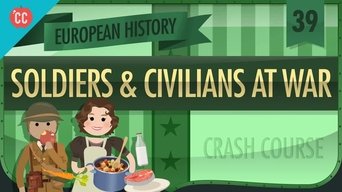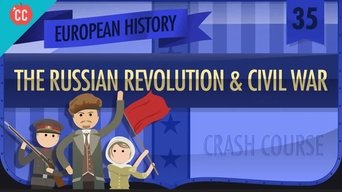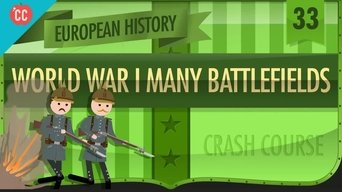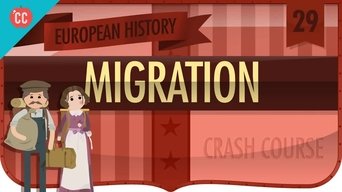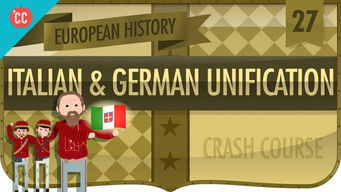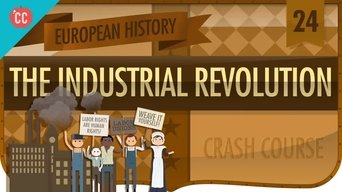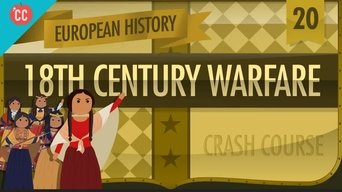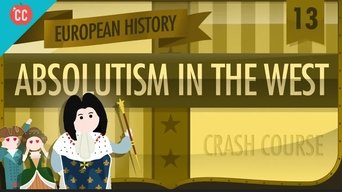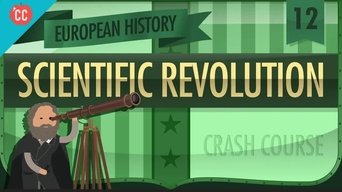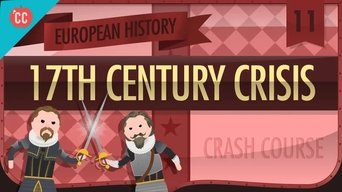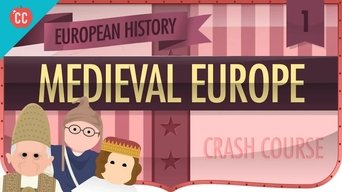Crash Course European History Season 1
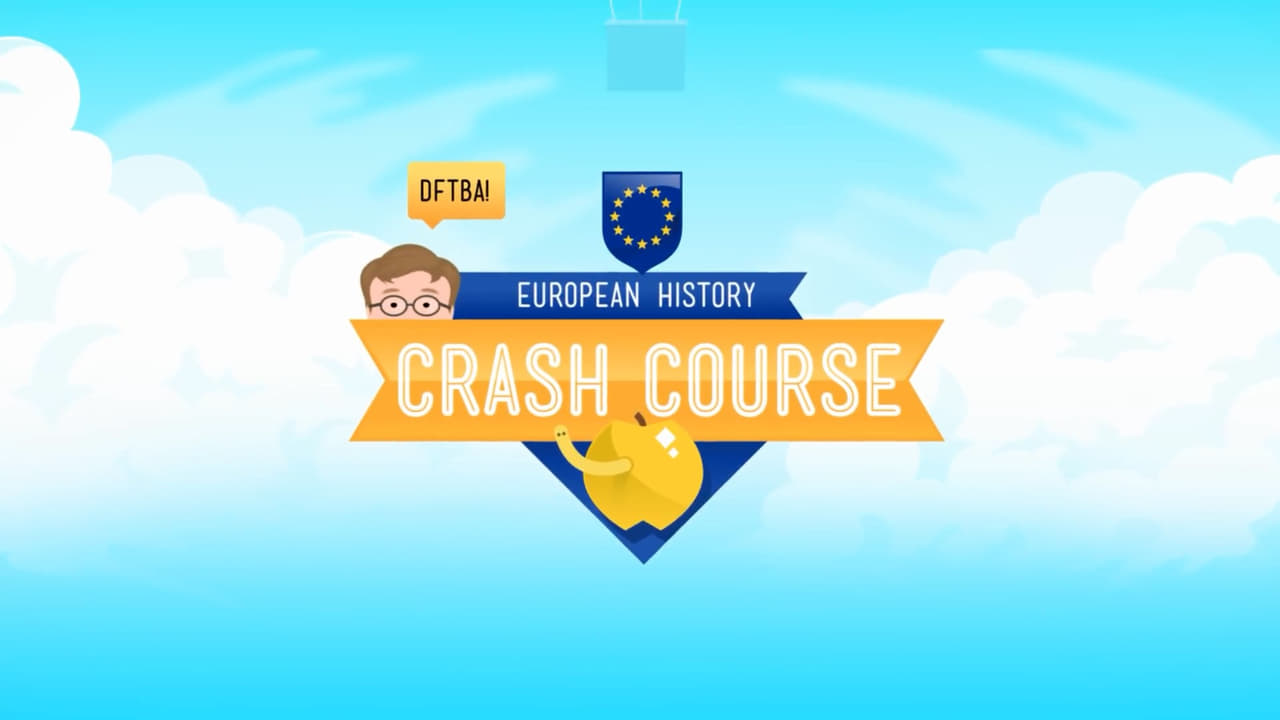
John Green is teaching history again. This time, we're looking at the history of Europe in 50 episodes. We'll start at the tail end of the so called Middle Ages, and look at how Europe's place in the world has developed and changed in the last 700 years or so.
Watch NowWith 30 Day Free Trial!
Crash Course European History
2019
John Green is teaching history again. This time, we're looking at the history of Europe in 50 episodes. We'll start at the tail end of the so called Middle Ages, and look at how Europe's place in the world has developed and changed in the last 700 years or so.
Watch Trailer
With 30 Day Free Trial!
Crash Course European History Season 1 Full Episode Guide
At the end of our journey through modern European history, we're taking an episode to look back at how the practice of history developed and what the aim and goals and purpose of history have been. We'll also take time to consider how we should approach history research and writing going forward.
The 21st century brought a whole new host of challenges to the world, and Europe was no exception. In this video you'll learn about how an increasingly connected and complex world led to some pretty deep rifts in countries across the continent. We'll learn about financial crises that rippled across the world. We'll learn about wars and resultant migrations that sowed discord in many European nations. Increasing polarization and populism played out in movements like Brexit in the UK. While we don't know what the future holds, an understanding of the roots of conflict can help create a roadmap for the future.
In which John looks at what it even means to live in a global age, as we've been talking about Europe's role in the gobal community for 47 episodes now. But, pedantry aside, the world is more connected than ever, and that has had effects in Europe. Today we'll investigate how trade, communications, and disease have changed the continent.
The aftermath of the collapse of the Soviet Union and its Warsaw Pact had a huge impact on the countries of Eastern Europe. As the former satellite states turned away from communism and Soviet influence, some of them shifted toward democracy in an orderly way, and some descended into violence and bloodshed and ethnic recrimination. In many ways, this collapse is still playing out today. In this video you'll learn how countries like Czechoslovakia, Yugoslavia, Poland and many others moved into the post-Soviet world.
In the late 1970s and throughout the 1980s, protests and unrest continued continued across Europe, and the Soviet Union was having increasing trouble holding its sphere of influence together. Today you'll learn about the labor strikes of Poland, the dissident punks of East Germany, the fall of the Berlin Wall, and the breakup of the Soviet Union, among other things.
The post-World War II decades in Europe are sometimes called the Thirty Glorious Years. As those years wore on, tensions between East and West grew, and economic growth slowed or was unevenly distributed across Europe, protests and dissent arose across the continent.
In the decades following World War II, life changed in many ways, and a fair number of those changes were for the better. Many of those improvements were driven by advances in science and technology, in fields like biology, communication, energy production, space exploration, and especially medicine.
After World War II, Europe was changing radically, and its place in the world was changing as well. European powers had colonized around the world in the 18th and 19th centuries, and in the 20th century, it all came crashing down. Of course the degree of crashing was variable from country to country.
At the end of World War II, the nations of Europe were a shambles. Today we'll learn about how the various countries and blocs approached the problem of rebuilding their infrastructure and helping their residents recover. You'll learn about the Marshall plan and the various treaties that led to the modern day European Union.
Sometimes, friendship isn't forever. At the conclusion of World War II, the old structures of power were a shambles. The traditional European powers were greatly weakened by years of total war and widespread destruction. The USSR was looking to expand its sphere of influence in Eastern Europe, and at the same time, the United States was assisting with the rebuilding of Western Europe (with some hegemonic strings attached). As two nuclear-armed superpowers emerged, the world entered the Cold War.
During World War II, Nazi Germany undertook the imprisonment and summary execution of many of its own citizens, and citizens of the nations they occupied. One of the groups that came under assault was the European Jewish population. More than six million Jewish people were killed in a systematized genocide. Five million more people died in the same time frame as a result of Nazi persecution. In addition to the Jews, Roma people, homosexuals, political dissidents, Polish people, Slavic people, black people, and many other perceived enemies were imprisoned and killed by the regime.
Our look at World War II continues with a closer examination of just how the war impacted soldiers in the field, and the people at home. For many of the combatants, the homefront and the warfront were one and the same. The war disrupted life for millions upon millions of people. You'll learn about the different experiences of the populations of various combatant states.
Only a couple of decades after the end of the First World War--which was supposed to be the War that Ended All Wars--another, bigger, farther-flung, more destructive, and deadlier war began. Today, you'll learn about how the war in Europe progressed, from the Molotov-Ribbentrop pact and the invasion of Poland, to the Western and Eastern fronts, to VE Day and the atom bombs used in Japan.
We're still leading up to World War II, but first we gotta talk about the rise of the dictators. Today we talk about the rise of militaristic dictatorships in Germany, the Soviet Union, Japan, and Spain, and the economic depression that set the stage for their rise.
In which John Green looks at Europe's attempts to recover from the devastation of World War I and forge a lasting peace. The peace did not last. Today we're talking about the economic cultural recovery of the 1920s, and the economic depression of the 1930s, and the fragile state of Europe after the Great War. We'll also look at the rise of fascism via the auspices of populist leaders like Adolf Hitler and Benito Mussolini, and we'll set the stage for the war to come.
World War I was very hard on the Russian Empire. So hard, in fact, that it led to the end of the Russian Empire. As the global conflict ground on, Tsar Nicholas II faced increasing unrest at home. Today we'll learn about the Revolutions of 1917, the rise of Lenin, Trotsky, and the Bolsheviks, and the Reussian Civil War and the creation of the Soviet Union.
World War I was a total war for millions of people in Europe. Many men were enlisted in the fighting, but the war work had implications for the daily lives of a huge number of Europeans. Women entered the workforce in huge numbers, and for a lot of people, the battles raged through their towns, cities, and even their homes. In addition to learning about the homefronts of the war, we're going to look at how the war ended, and how the Paris Peace Conference and the treaties that resulted did little to heal the societal wounds of the war, and in many ways set the stage for the next big war.
Europe's system of alliances and centuries-old tensions erupted into war in August of 1914. This week on Crash Course Euro, we're talking about the military history of World War I, and taking a look at the broad strokes of how the war unfolded. We'll take you from the guns of August through gruesome battles like Verdun and the Somme, and follow the thread all the way through to the Armistice in 1918. It didn't turn out to be the War to End All Wars, sadly, but there is a lot to learn from it.
Much has been written about what exactly caused World War I. As befits a true global war, the reality is that there isn't a single cause. There aren't even three causes. There are a vast array of causes. Today we'll get into just a few of those causes, including the complex system of alliances in Europe, the myriad military conflicts that played out in the years and decades leading up to the war, and the event that many point to as the beginning: the assassination of Archduke Franz Ferdinand.
Europe was in transition politically and culturally at the beginning of the 20th century. Today, we're looking at the dawn of modern science, and the rise of Modernism in the arts, especially in music, dance, and visual arts. We'll look at changes in music and dance with Stravinsky's Rite of Spring, and explore the groundbreaking visual art of the Impressionists.
So, "modern" is kind of a loaded term, but today we're going to talk about modern life in Europe, as it looked around the time the 19th century turned into the 20th. We'll look at what life was like in the rapidly growing urban centers of Europe, how developments in communication and information distribution influenced the way people saw their leaders and their neighbors, and how women began making strides toward equality in this era.
Between 1840 and 1914, an estimated 40 million people left Europe. This is one of the most significant migrations in human history. So, who was leaving Europe? And why?
In 19th century Europe, with nation building well under way, thoughts turned outward, toward empire. This week, we're looking at how Europeans expanded into Africa, Asia, and Oceania during the 1800s. You'll learn about China and the Opium War, British India, and the Scramble for Africa.
So, we haven't talked much about Italy and Germany so far in Crash Course Euro, and that's because prior to the mid-19th century, those two nation-states weren't really a thing. Today we'll look at how Italy and Germany pulled it together in the second half of the 1800s. You'll learn about Guisseppe Garibaldi, Victor Emmanuelle, Otto von Bismarck, Wilhelm I, and a whole heck of a lot about the development of modern politics.
In 1848, Europe experienced a wave of revolutions. Last week we covered some of the reform movements that presaged these uprisings. This week, we're learning about what the people wanted from the revolutions, who was involved, and how many of those goals were accomplished. We'll look at revolutions in the Austrian Empire, Hungary, Italy, the German States, and the region formerly known as Poland.
In the aftermath of the revolutions and upheaval in 18th and early 19th century Europe, there was a hunger for reform across the continent. Reformers like Robert Owen, Charles Fourier, and Auguste Comte proposed radical new ideas, and at the same time, regular people began to stand up and ask for greater equality, and a louder voice in how they were governed. Results were mixed, but a lot of the ideas that emerged during this time are still echoing in our world today.
We've talked about a lot of revolutions in 19th Century Europe, and today we're moving on to a less warlike revolution, the Industrial Revolution. You'll learn about the development of steam power and mechanization, and the labor and social movements that this revolution engendered.
The end of the Napoleonic Wars left the great powers of Europe shaken. Judging from the destruction that had been wrought across the continent, it seemed to the powers that be that the Enlightenment had liberated the people, and led to disaster. So, everybody got together in Vienna to have a Congress, and to try to put Europe "right" again. By "right" I mean they wanted to go back to the old days of kings, queens, and nobles running the show. But this new yearning for the past pervaded the continent. Roomanticism arose at the same time, looking back at (imagined) golden age of Medieval Times. Today we'll talk about the Congress of Vienna, The Holy Alliance, and the Romantic movement across the arts.
We try not to get into too much great man history here at Crash Course, but we have to admit: Napoleon Bonaparte is a pretty big deal. Join us as we track the rise, further rise, fall, rise, fall, mortal fall, and posthumous rise of Napoleon. This guy changed France, he changed Europe, and in a lot of ways he changed the world.
In 1789, the French Monarchy's habit of supporting democratic popular revolutions in North America backfired. Today, we're talking about the French Revolution. Across the world, people were rising up to throw off monarchies, and Louis didn't see the writing on the wall until it was too late. Today we'll talk about how the French Revolution unfolded, and what (if anything) was really accomplished. You'll learn about stuff like the National Assembly, the Tennis Court Oath, the Declaration of the Rights of Man and the Citizen, the guillotine, Robespierre, and a bunch of other kind of unbelievable details.
European powers had a lot of wars in the 18th century, and they weren't confined to Europe. Conflict raged across the globe, in what might be called a World War...but we don't call it that, because we already have a couple of those coming up in the 20th century. Some call it the Great War for Empire, and some call it a bunch of separate wars, but in any case, all this conflict was important, and you're going to learn all about it right now.
Last time we learned about the Enlightenment, and the philosophers and thinkers whose ideas would shape governance for hundred of years. This week, we're learning how monarchs across Europe were influenced by those ideas. Adoption of Enlightenment ideas across Europe was...uneven, to say the least. In this episode you'll learn about Catherine the Great of Russia, Frederick the Great of Prussia, Maria Theresa of the Habsburg Dynasty, and Joseph II, her successor. We'll also get into the impact the Enlightenment had on a series of Louis in France.
So far in this series, we've covered a lot of war, disease, climate disaster, and some more war. Well, prepare yourself for something a little more positive. This week, we're talking about the Enlightenment. In this video, you'll learn about the ideas of Voltaire, Rousseau, Montesquieu, Kant, Smith, Hume, and a bunch of other people whose ideas have been so impactful, they still influence the way we think about the world today.
In eastern Europe, in the 17th century a couple of "great powers" were coming into their own. The vast empire of Russia was modernizing under Peter the Great, and the relatively tiny state of Prussia was evolving as well. Russia (and Tsar Peter) reformed many aspects of Russian governance, realigning them toward the way things were done in western Europe. In Prussia, efficiency of institutions became a thing, and Prussia turned into "a large army with a small state attached."
While the focus has been on Western Europe so far, there has also been a lot going on in Eastern Europe, which we'll be looking at today. The Commonwealth of Poland-Lithuania, The Ottoman Empire, and Russia were all competing at the eastern end of the continent/landmass of Europe at during the 16th century. You'll learn about the various Ivans in Russia, and the Time of Trouble that followed them, and you'll learn about the Ottomans' expansion into Europe. You'll also learn how the great power you may not have heard of, Poland-Lithuania was right in the middle of all these events, from the rise of the False Dmitry to the Battle of Vienna.
While the English were falling apart a little, with their civil war and their restoration and their succession problems, the Dutch were getting their act together. They were throwing off the yoke of the Spanish Empire, uniting their provinces, and building out their global trade network. Today, we'll learn about how the Dutch came to their Golden Age, and how it ended.
The English Civil War. We'll talk about England after Elizabeth, in which things didn't go that smoothly. We'll talk about James I, Charles I, Oliver Cromwell, Charles II, and James II, all of whom ruled England, (and tried to rule all of Britain and Ireland) with varying degrees of success.
So far, the rulers of Europe have been working to consolidate their power and expand their kingdoms, and this is it. The moment they've been working toward: Absolute Monarchy. We're going to learn about how kings and queens became absolute rulers in Europe, and where better to start than with Louis XIV of France, who is really the model for absolute rule.
There was a lot of bad stuff going on in Europe in the 17th century. We've seen wars, plagues, and unrest of all types. But, there is some good news. Huge advances were underway in the scientific community in Europe at this time. In this video we'll look at the progress of knowledge with Galileo, Copernicus, Kepler, Harvey, Newton, and more.
The 17th Century in Europe was pretty rough in a lot of ways. The Thirty Years War involved a lot of countries, and a lot of battles, and it was terrible for everyone involved, as wars have aa historical tendency to be. At the same time, disease and hunger were common, thanks in part to the climate change of the Little Ice Age. Get ready for some misery.
During our last several episodes, Europe and the European-controlled world have been in crisis. Wars, disease, climate changes, and shifts in religious and political power threw the European world into turmoil. People were looking for a scapegoat, and for many it was a time of magical thinking. So, maybe witches were responsible for all the problems? It was a popular idea, but, alas, the witches weren't responsible.
When the Protestant Reformation broke out in Western Europe, the Catholic Church got the message, at least a little bit. Pope Paul III called a council to look into reforming some aspects of the Catholic Church and try to stem the tide of competing Christian sects popping up all over the place. The Council of Trent changed some aspects of the organization, but doubled down on a lot of the practices that Martin Luther and other reformers had a problem with. Today you'll learn about the Council of Trent, the rise of the Jesuits, and Saint Teresa of Avila.
We've been talking a lot about kings, and queens, and wars, and religious upheaval for most of this series, but let's take a moment to zoom out, and look at the ways that individuals' lives were changing in the time span we've covered so far. Some people's lives were improving, thanks to innovations in agriculture and commerce, and the technologies that drove those fields. Lots of people's lives were also getting worse during this time, thanks to the expansion of the Atlantic slave trade. And these two shifts were definitely intertwined.
The Protestant Reformation didn't exactly begin with Martin Luther, and it didn't end with him either. Reformers and monarchs changed the ways that religious and state power were organized throughout the 16th and early 17th centuries. Jean Calvin in France and Switzerland, the Tudors in England, and the Hugenots in France also made major contributions to the Reformation.
You may have noticed that the internet is terrible at religious discourse. Well, this is not a new phenomenon. In the early 16th century, the Roman Catholic church dominated Christianity in Europe, and the institution was starting to show some cracks. Tensions mounted and protests grew, and eventually, the Protestant Reformation happened. Martin Luther nailed his 95 Theses to the church door in Wittenberg, but the Reformation doesn't exactly begin with Luther, and it certainly doesn't end with him. Today, we're looking at how and why the Catholic church in Europe split, first into two sects, and eventually into a LOT of sects.
European exploration had a lot of side effects. When the Old World and the New World began to interact, people, wealth, food, animals, and disease began to flow in both directions. In the New World, countless millions were killed by smallpox, measles, and other Old World diseases. Old World animals changed life in the New World irrevocably, and the extraction of wealth and resources from the Americas ultimately contributed to the development of the Atlantic Slave Trade. So, it was an exchange with a lot of downside, especially for non-Europeans.
The thing about European History is that it tends to leak out of Europe. Europeans haven't been great at staying put in Europe. As human beings do, the people of Europe were very busy traveling around to trade, to spread religion, and in a lot of cases to try and conquer other people. In the 15th and 16th centuries, Europeans developed a bunch of tools and techniques that would allow them to travel around the world, in numbers and force heretofore unseen on the planet. And a lot of the results weren't great for the people who already lived in the places Europeans were "visiting."
The European Renaissance may have started in Florence, but it pretty quickly moved out of Italy and spread the art, architecture, literature, and humanism across Europe to places like France, Spain, England, and the Low Countries.
The Renaissance was a cultural revitalization that spread across Europe, and had repercussions across the globe, but one smallish city-state in Italy was in many ways the epicenter of the thing. Florence, or as Italians might say, Firenze, was the home to a seemingly inordinate amount of the art, architecture, literature, and cultural output of the Renaissance. Artists like Michelangelo, Leonardo daVinci, Sandro Boticelli, and many others were associated with the city, and the money of patrons like the Medici family made a lot of the art possible. Today you'll learn about how the Renaissance came to be, and what impact it had on Europe and the world.
Our European history is going to start around 1500 with the Renaissance, but believe it or not, that is not the actual beginning of history in the continent. So, today, we're going to teach you the broad outlines of the so-called Middle Ages, and look at events like the Black Plague, the Hundred Years War, and the Western Schism of the Catholic Church that set the stage for the history of modern Europe.
Free Trial Channels
Seasons


